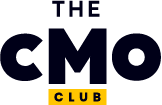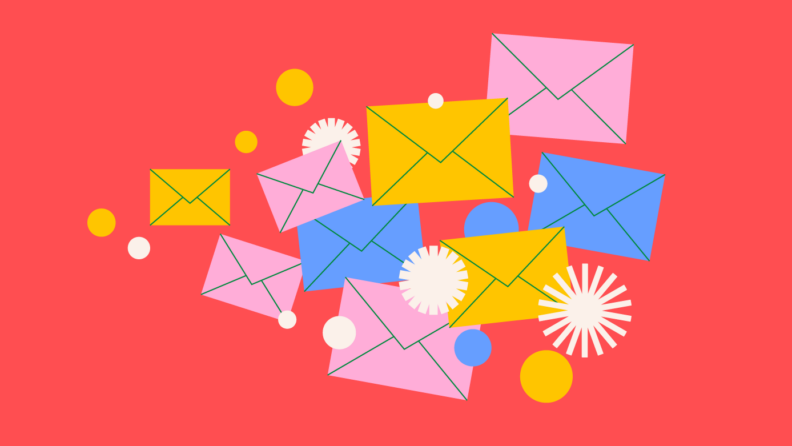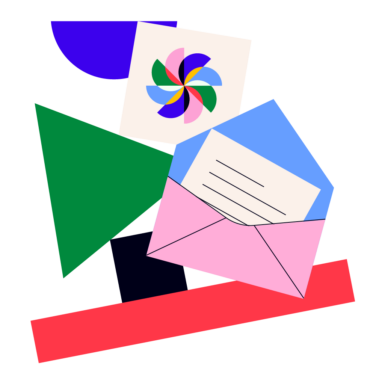If you’re struggling to turn B2B email marketing into a lead generation engine, you’re not alone. In this article, I'll outline some actionable tips that you can use to improve your B2B email marketing efforts, provide some specific examples of companies who are doing a great job with their B2B emails, and share some of my most highly recommended email marketing software.
You’ll also learn best practices for:
- Choosing the right ESP (email service provider)
- Building an email list
- Audience Segmentation
- Content Personalization
- Automation Use Cases
Take a couple (or all) of these tips to test them out in your business, and may you see your results soar!
What is B2B Email Marketing?
B2B email marketing connects your business with potential customers who are also businesses. I see it as one of the most efficient ways to build relationships, drive revenue, and support your sales pipeline.
When I run B2B email marketing campaigns, I focus on delivering value across the entire customer journey. These campaigns aim to inform, engage, and convert, not just to broadcast messages.
Here is how I define B2B email marketing:
- A targeted communication strategy built for business decision-makers
- Designed to nurture relationships over longer sales cycles
- Structured to support both demand generation and customer retention
- Monitored through key performance indicators like open rates, click-through rates (CTR), conversions, and contribution to pipeline.
According to Forbes, 50% of marketers say email is their most effective channel for driving revenue (Forbes, 2024).
How are B2C and B2B Email Marketing Different?
While B2B and B2C both leverage email marketing, they serve fundamentally different audiences and purchase behaviours. Your B2B email marketing strategy should reflect this difference.
Key distinctions to consider when building B2B email sequences:
- Audience: B2B emails target professionals making purchasing decisions on behalf of their organizations. B2C emails target individual consumers.
- Buying Cycle: B2B sales cycles are longer and more complex. Emails need to educate and build trust over time.
- Content: B2B emails often deliver in-depth resources like white papers, case studies, and product guides. B2C content focuses more on emotional triggers and quick conversions.
- Demographics: Segment based on industry, job title, company size, and purchase readiness, rather than age, gender, or lifestyle.
Why Do You Need a B2B Email Marketing Strategy?
Because B2B email marketing is fundamentally different from B2C, it requires a more deliberate, strategic approach. In B2C, email campaigns can often succeed with short-term promotions or emotional hooks. In B2B, where sales cycles are longer and decisions involve multiple stakeholders, a well-defined strategy makes the difference between random outreach and meaningful engagement.
Here is why B2B email marketing campaigns need strategy:
- Complex buyer journeys: B2B buyers move through a longer decision process. Your email sequences should nurture trust and provide relevant content and information at each stage.
- Multiple decision-makers: You often market to teams, not individuals. Segmenting your messaging for key demographics and roles ensures each stakeholder receives value.
- Relationship-driven selling: Unlike many B2C campaigns that focus on quick conversions, B2B campaigns build relationships over time. Your strategy should reflect this.
- Higher stakes: B2B purchases often involve significant investment. A thoughtful B2B email marketing strategy helps establish credibility and authority in your space.
- Measurement for growth: With strategy in place, you can track performance, test content, and optimize your digital marketing program continuously.
In short, a strategy-first mindset turns B2B email marketing campaigns from an afterthought into a core driver of lead generation and revenue growth.
10 B2B Email Marketing Best Practices
These are the core best practices to create effective email sequences that support every stage of the buyer journey.
1. Choose the Right Email Service Provider
Selecting the right email service provider (ESP) is one of the most important decisions I make when setting up B2B email marketing campaigns. The right platform allows me to scale personalized email sequences, manage complex lists, and automate drip campaigns that nurture potential customers over time.
Here is what I look for when choosing an ESP as part of my marketing tool stack:
- Robust automation features: I want to build sophisticated drip campaigns that adapt to user behavior and move leads through the funnel.
- Segmentation and targeting: The ESP must support advanced segmentation so I can tailor messages to different demographics, roles, and buyer stages.
- Deliverability: High deliverability rates are non-negotiable. I choose providers with strong reputations and tools to help avoid spam filters.
- Integration with my CRM and other tools: A good ESP integrates seamlessly with my CRM, marketing automation platform, and analytics tools to support a cohesive digital marketing strategy.
- Ease of use and scalability: The platform should be intuitive for my team and capable of supporting both small campaigns and large-scale B2B email marketing efforts.
In my experience, investing time in selecting the right marketing tool up front prevents major headaches later. The right ESP gives me the foundation to build high-performing drip campaigns that drive consistent lead generation.
2. Segment Your Email List
If you run marketing campaigns on social media, you probably already have buyer personas in mind when you’re designing creatives for those campaigns. Treat your email list in a similar way. Use the information you have on your subscribers to segment your lists, so you can personalize your emails to who you're trying to reach, such as key decision-makers at a smaller business who are ready to buy or individuals you met at a trade show.
It’s not uncommon for businesses to have multiple mailing lists targeting different sizes of businesses or different locales. You may opt to maintain lists for current customers, press contacts, lapsed customers, and new leads. When you’re considering how to categorize your customers, ask yourself if what you’re doing will make it more likely that the emails they’ll receive will be relevant to (and therefore opened by) them.
3. Choose A Compelling Subject Line
No guide to B2B email marketing best practices would be complete without mentioning the subject line. Email inboxes are crowded, and the email subject line is the only chance you get to attract a person’s attention. If you have poor open rates, it’s likely your email subjects are lacking in some way. They could be too bland, or they could make your messages look like spam.
If you’re unsure what the issue is, experiment with a few subject lines, and try using email testing software to A/B test which subjects attract the most attention. Every industry is different, so be ready to experiment until you figure out what works. If it helps, there are some great email marketing templates you can try out.
Whatever subject line you choose, make it descriptive and include your brand name if possible, so people know it’s from you. Not all subscribers will open every single one of your emails, even if they want to remain subscribed. However, your branding benefits from them seeing your name in their email inbox, even if they haven’t read your most recent mail.
4. Include A Strong Call To Action
Once you’ve got people to open your emails, the next challenge is to get them to take action. Try to make each email have a clear point and a call to action (CTA). Depending on your sales pipeline, that call to action could be anything from “visit our website” to “schedule a demo with our sales team."
Whatever it is you want your subscribers to do, make it easy for them to follow through and include clear, visible calls to action in the message.
When it comes to writing calls to action, follow the same rules for emails as you would for more traditional online marketing. Try to choose compelling and descriptive calls to action, such as “Sign up for the webinar” or “Preorder the report.” These descriptive calls typically see a better response than something vague, such as “Click here.”
Make whatever it is you’re asking the reader to do as simple and friction-free as possible. For example, if you’re inviting someone to download a report or join a webinar, don’t make them click a link in an email and then fill out all of their details again. You already know who the user is because you’ve sent them an email. Use this to have some of their details prefilled to save them time.
5. Be Consistent With Your Campaigns
Spamming your subscribers with too many messages is an effective way of alienating prospective customers. However, if you go too long between sending emails you run the risk of people forgetting that they’ve subscribed.
Even if you don’t run into spam issues, intermittent emails aren’t particularly effective when it comes to generating solid email open and conversion rates. Try to stick to a steady schedule. For example, pick one day of the week and send your messages at a fixed time that day so your audience will get used to seeing your messages. If your email content is good enough they could even come to look forward to them.
Depending on the industry you’re in and the theme of your mailing list, you may be able to get away with sending more frequent emails. For example, a daily news roundup may be popular with some subscribers. Whatever schedule you decide to follow, it’s important to stick to it. Don't switch from a low-volume schedule to a high-volume schedule without your user’s consent. If you're unsure, try hosting a poll in one of your emails asking how frequently they'd like to hear from you.
6. Optimize Email Deliverability
Using a reliable mailing list platform is important for any marketer. However, it’s particularly important for B2B companies that may use email hosting that has aggressive junk mail filtering settings. Some CRM software includes tools to help you manage mass emails and large lists of email subscribers. If yours doesn’t, you may want to use a specialist B2B email marketing service or platform. Useful features to look out for include:
- Double opt-in lists
- Unsubscribe requests
- Welcome messages
7. Automate the Buyer's Journey
Automation can help you scale B2B email marketing campaigns without sacrificing relevance or personalization. Here are some of the most effective ways use cased for email automation workflows across the entire B2B buyer’s journey:
| Use Case | Workflow Example | Targeted Outcome |
| Welcome new leads | Automated welcome flow triggered when a lead submits a form or signs up for content | Introduce your brand, deliver value, and set expectations |
Nurture mid-funnel leads | Multi-step nurture workflow triggered by engagement (e.g. content download or webinar attendance) | Educate and move leads toward sales readiness with relevant, sequenced content |
| Onboard new customers | Onboarding workflow triggered after purchase or contract signing | Guide new customers through product setup, adoption, and value realization |
| Re-engage inactive leads | Re-engagement workflow triggered after 30+ days of inactivity or no email opens | Rekindle interest, offer new value propositions, and bring leads back to active engagement |
| Promote events or webinars | Event-specific drip campaign triggered for registrants and no-shows | Drive attendance, build excitement, and follow up post-event |
| Upsell or cross-sell | Account-based workflow triggered by product usage signals or upsell criteria | Deliver highly relevant offers based on current product adoption |
| Renewals and contract reminders | Renewal workflow triggered 60–90 days before subscription or contract expiration | Prompt timely renewals and reduce churn with proactive, personalized outreach |
| Customer advocacy and referral | Advocacy workflow triggered by NPS score or satisfied customer signals | Invite satisfied customers to leave reviews, refer peers, or share testimonials |
8. Keep Content Scannable
If you’re using email as a major marketing channel, you’ll want to make a good impression on your subscribers. An attractive email template is a good starting point, but the text of the email needs to be clear and easy to read. That means breaking it down into short paragraphs and keeping the formatting simple with plenty of white space.
There are still people out there who use text-only email clients or disable the loading of images in their mail software. Those people could be key decision-makers, so ensuring your emails are accessible is essential.
Keep your emails relatively lightweight. Compress images, always include alt text, and don’t send huge attachments to people unless they’re expecting them. Even when using video email marketing software, it’s important to optimize for accessibility to avoid clogging inboxes or triggering unsubscribes, especially for recipients on the go.
If you fill up someone’s inbox while they’re traveling, you run the risk of them hitting the unsubscribe button once they notice what’s happened.
9. Personalized High Value Content
The people you’re targeting with your marketing emails are most likely busy people who have a reasonable amount of power within the business. By subscribing to your mailing list, these people are allowing you to take some of their valuable attention. If you want to remain welcome in their inbox, you need to give them value in exchange for their time.
Think about who your target audience is and the problems they typically face during the working day. What do they need to know about? What could they learn from you? What pain points do they have, that your product can fix?
If you attract new subscribers by offering a free trial of your software or service, sending out tips and tutorials on how to make the most of the trial is a good starting point. You could also offer case studies of other, similar organizations that have made use of the product. Use these case studies to highlight key functionality that you think might interest them.
You can also use your email newsletter to provide tips and advice that are loosely related to your business. For example, if you run a web design agency and you know a lot of your prospects are going to a conference, send a “conference survival guide.” Include networking tips and lighthearted advice about avoiding “the conference flu.”
Free, useful content can attract attention and build goodwill among many of your subscribers. Later in the sales cycle when it’s decision-making time, your audience will be more likely to view your brand in a positive light.
10. Track Metrics And Refine As You Go
As with any other kind of content marketing, metrics are king. Your email marketing analytics tools will most likely have options for you to keep track of things such as new subscribers, deliverability, open rates, and click-throughs.
Check these metrics regularly, and use them to refine your marketing efforts. If people are opening your messages but aren’t clicking through, try changing your email design or tweaking your CTAs. If you don’t have good open rates, consider the subject line or whether the content of your emails is just not appealing.
Remember, the sales process for large business-to-business purchases can take longer than the process of selling cheaper fast-moving consumer goods. The scope of B2B marketing is about building trust and reputation, and it can take a long time to seal a contract.
3 Great B2B Email Marketing Examples
1. Buffer's Welcome Email
When you sign up to Buffer you'll receive a welcome message that is short and simple. It sets the tone for what they offer and delivers a clear message that they're always just an email away.
Buffer's welcome mail is a great example of "less is more." The mail is text only except for the company logo and is entirely clutter-free. Thanks to this, it communicates its message incredibly clearly.

2. Docusign's Mailing List
Docusign's B2B mailing list offers informative articles about online security. The emails they send out include useful information about privacy, data protection, and security. Docusign uses its articles to clear up some concerns prospective customers may have about their software.
What makes the mailing list so effective is that not all of the articles they send out are sales-focused. There are useful, informative articles included that don't directly relate to the products they sell. This is a great example of adding value.
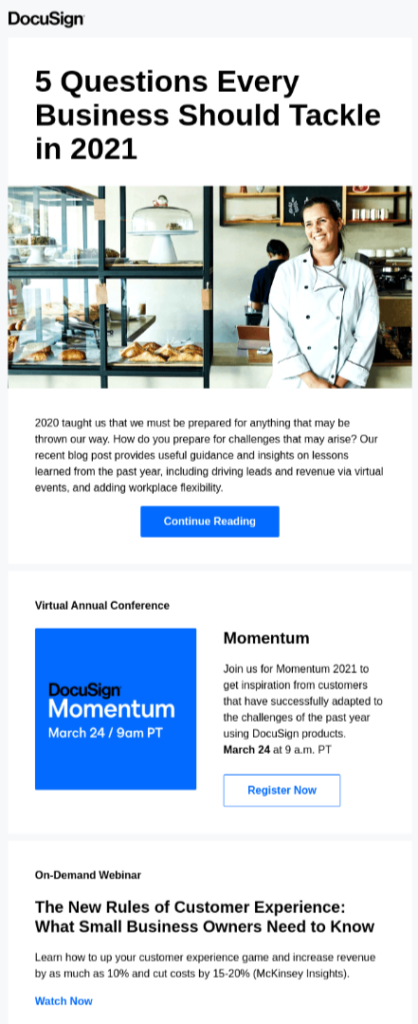
3. Salesforce's Blog Updates
Salesforce offers people the option of subscribing to a mailing list to get blog highlights delivered directly to their inboxes. We're highlighting this update email because of its eye-catching design and the varied types of content included in the emails.
Salesforce is used by people from many industries. They've done a good job of creating a regular email blast that will be appreciated by a wide audience.
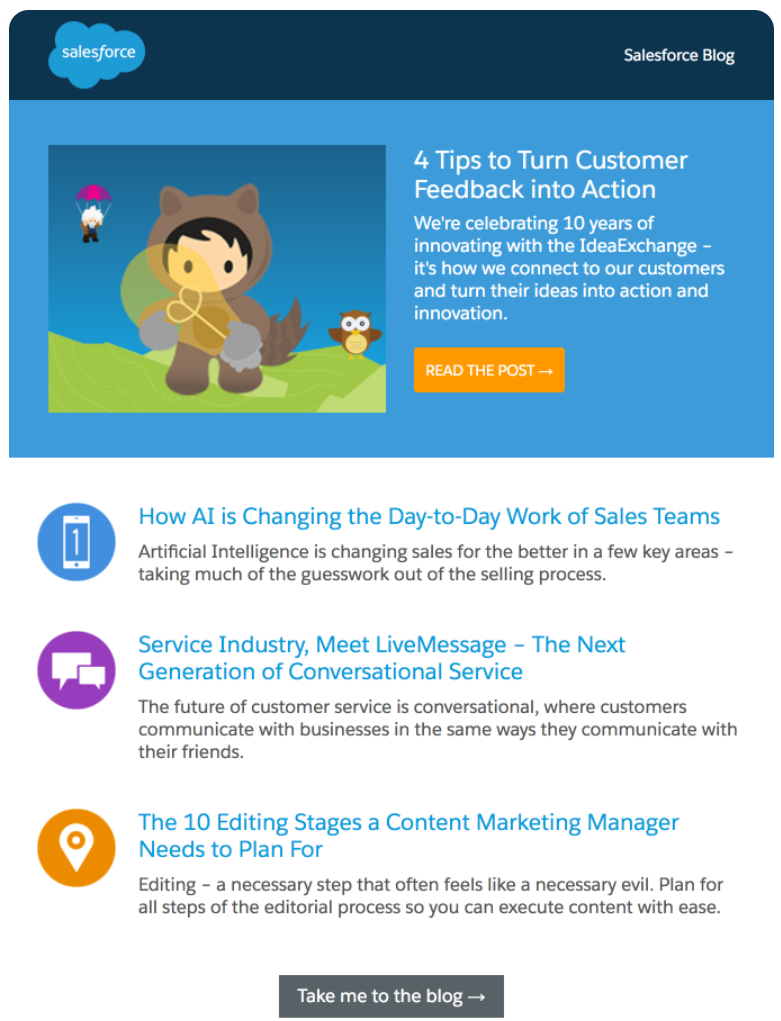
B2B Email Marketing Tools
Here’s a list of my preferred email marketing software. These platforms can help you manage your mailing list, keep track of new customers and subscribers, and send out personalized emails. Many of these platforms offer free email marketing versions or trials, so you can experiment before committing to a subscription. Also keep in mind that pricing often scales with list size and features, so it’s worth reviewing the fine print before you dive in.:
Set Your B2B Email Marketing Strategy in Motion
Email marketing is a powerful tool when it’s used correctly. In fact, it's possible to achieve ROIs in excess of 40:1 with email marketing, depending on the niche.
As with other marketing methods, it can take some time to refine your marketing efforts. With proper list segmentation and automated workflows, you can feel confident your B2B email messages will get the attention they deserve. For businesses looking to accelerate their results, partnering with specialized email marketing agencies can provide the expertise needed to optimize campaigns effectively.
For more marketing tips, news and advice, sign up for The CMO newsletter. We offer actionable tips to help you refine each aspect of your marketing strategy.
